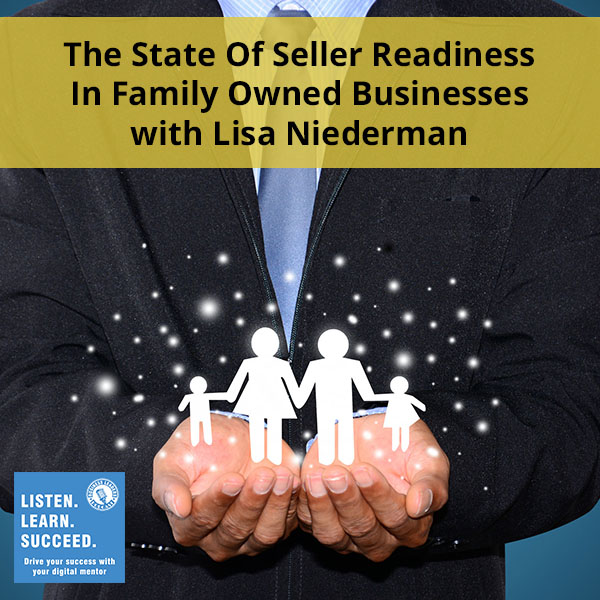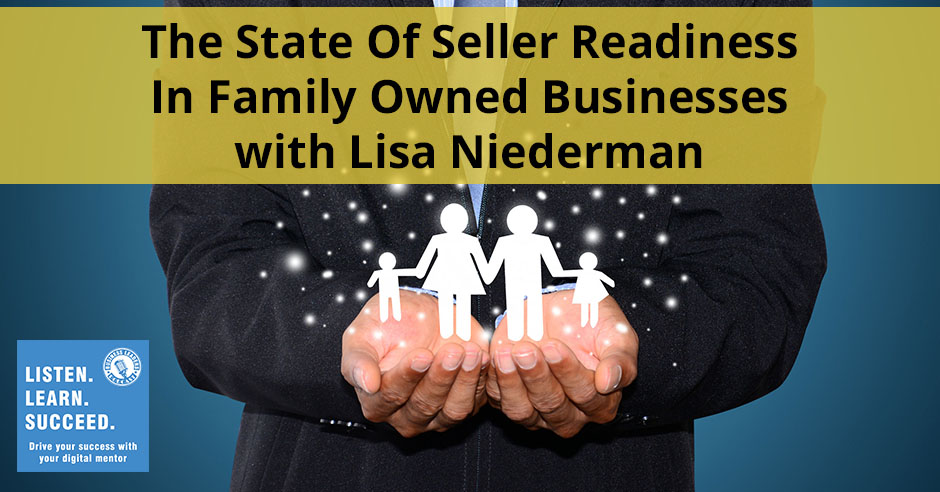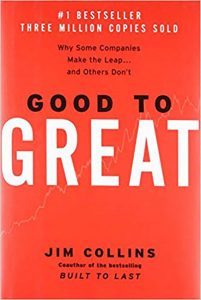The State Of Seller Readiness In Family Owned Businesses with Lisa Niederman


There are about 75% of closely held family business owners in the country. Yet, 85% of those have not completed the transition and succession plan. As a result, 25% of businesses close while others have to sell, cutting their family ties and emotional investment with it. Lisa Niederman, managing director of Speed2Results, talks about the importance of planning for your destination and preparing your business for succession. Sharing her own story and background in psychology as well, she discusses the state of owner readiness and the common problems with business owners. She also covers the processes of transition—from selling to buying—and the need for value drivers.
The State Of Seller Readiness In Family Owned Businesses with Lisa Niederman
We’re incredibly fortunate. We have Lisa Niederman. She is the Managing Director of Speed2Results. Lisa, thank you so much for allowing us to come into your home.
Bob, what a pleasure. I’ve been excited about doing this interview with you and I’ve heard all about it. I’m ready to get started.
Lisa, tell me about your business and who you serve.
Speed2Results is about focusing on closely held family-owned businesses in transition. It’s particularly working with the owners, the rising generation, the nonfamily executives, and the partners in helping them look at the emotional and behavioral challenges that they’re experiencing with succession. There’s a lot of succession going and continuity. How do you grow the business? How do you create that legacy and getting it ready for sale? We call this seller readiness. It’s the people side of the transition journey that ensures improvement in value drivers and optimum valuation.
For the folks in our audience, they’re going, “What is that entire touchy-feely thing?” I don’t think they’re aware of the statistics for the quantities of businesses that come to market that don’t sell. Can you share some of your experience and understanding of basically the state of owner readiness?
There are about 75% of closely held family business owners in this country. 85% have not completed a transition plan and that succession we’re talking about. 50% haven’t even started. Out of that, 75% regret it when they do sell because they’re not prepared. They spend approximately the next eighteen months in depression and anxiety, trying to find themselves because their identity was tied to their business. 25% of the businesses only close. That’s not much. When we talk about seller readiness or the emotional and behavioral side of getting the business owners ready, I know that sounds a lot of gobbledygook, it’s not. If you think about it, it’s the glue that makes that transaction or succession work and people aren’t paying attention to it.
We’re living in a volatile market. We don’t know what’s going to happen.
They’re paying attention to the advisors, the valuation, the attorneys, the CPAs, the investment bankers, and business brokers. What happens when the people side falls apart? What happens when the owner isn’t psychologically ready? They’re controlling. They’re a know-it-all. They’re not ready yet and they think they can do it in another three to five years. We’re living in a volatile market. We don’t know what’s going to happen. People think that they still can sell their business. They still have a right to sell their businesses. Nobody has a crystal ball. We don’t know that. You don’t know what’s going to happen if it’s a family business. What’s going to happen with your siblings and your cousins when they want out? Those are some of the issues that we’re talking about when we’re talking about emotional and behavioral challenges. That is what you have to address in order to make the continuity succession or the sale work.
You’re passionate about what you think about that. Let’s back up a little bit and talk about what led you down this path.
It goes back to my family. We were a family in a business. My grandfather started a furniture business and he had two sons, my father, and my uncle. They ran the business and it was on the south side of Chicago. It was a high-end living room furniture business. It was extremely successful. What I got to watch was my two older brothers got to go down and work at the factory. This is literally a factory on the south side, manufacturing firm, hammering nails into the furniture. We would go down there as kids, myself and my younger brother, and play on the factory floor, get chased out of there. I got to watch everything that was going on.
I tell this story because my father was a patriarch in our family. Everybody would go to him for his wise counsel. If there was any problem they would go to him. When I went down to the factory and I saw how he managed people, that made such an impression on me. In those days, in the ‘50s, ‘60s, ‘70s, it was an autocratic, militaristic and hierarchical model. You told people what to do. It wasn’t collaborative. It wasn’t team-focused. Here I am sitting, watching my father and my family, and then watching him as the boss CEO of this business. There’s a dissonance that’s created and I’m going, “There’s got to be a better way to do this.” That’s a phrase I’ve always said in my life. I’ve always come in and maximized what can we do, how can we do this better? That propelled me into a whole field of psychology, that whole practice in behavioral psychology before I came to business. That’s where I set the goal of combining psychology in business.
That business sold twice. In each of those, I was privy to the discussion. I wish I was a little bit older with the knowledge I have now. Back then I was so impressionable and I was listening to all these conversations. My father was a visionary in those days and I didn’t even know it. They were talking about mergers and acquisitions in the ‘70s. We only started talking about that in the ‘80s and ‘90s. I grew up in this family business that sold twice and it propelled me into this whole field of psychology. We’ve said, “I’m going to go get great at people first and then I’m going to come back to business and I’m going to integrate the two.” That’s what I’m made of. That’s what is in my DNA.
You grew up in business. You sat at the knee of the patriarch and learned. You got to see him sell it twice. There must’ve been a reason he sold twice. One probably didn’t work well. He got it back and sold it again perhaps. That would be the story that we’ve heard many times with business owners who did a failed sale, particularly when they’re carrying part of the note. As you look at business owners, what are the top one or two things that you think are the biggest holes in their bucket now?
 Family Owned Businesses: Business owners are moving so fast that they don’t think about their destination, where they are headed.
Family Owned Businesses: Business owners are moving so fast that they don’t think about their destination, where they are headed.
Business owners are moving so fast. Everybody talks about the speed of business. The problem is they’re not slowing down and working on their business. They’re busy growing it and we’re in boom times. Everybody’s talking about it, “I’m working on my business. I don’t need to worry about the valuation or what I’m going to get.” The problem is they’re not taking a couple of hours a week and looking at where they’re going. What is their destination? They’re not working on their business. I know your audience has heard this before. The thing is they’ve heard it before, but are they acting on it? Most people are not.
Why do you think that is?
It goes back to the speed of business. People are moving so fast, “I don’t have time to do that. I’ve got to do my next acquisition. I’ve got to get this next client. I’ve got to get this next proposal lot.” They don’t have the time to sit down and think about, “I am executing,” and there’s a lot of discussion on what is execution, but what are you executing against? Do you know your destination? I ask people that and a lot of the time they don’t.
Most of the folks think they’re immortal and, “That’s not going to happen to me.” That’s the typical thing, “It won’t happen to me.” Death and disability change the value of your business upon the event. You’re the business. Do you think that when you talk to your clients that they consider that risk level much?
They don’t because they think they’re omnipotent. As you said, “I’ve got another three to five years, I’ll handle it in three to five years,” then I get to another five years. “I’ll handle it in another three to five years.” It goes back to our denial about our mortality. It’s our mortality that our life is going to come to an end. Even with my own father, he was in the business until he was 79 and it took three people to replace him. I see that all the time. The owners and the founders go, “I’m not ready. I’m having too much fun.” What they’re not counting on is disability, illness and then you’ve got the rising generation going, “I’m ready, dad. I’m ready, mom. I want to do this. Let me do this.”
Death and disability change the value of your business upon the event.
The problem with that is if they don’t pay attention to nurturing them at least five to ten years out. I know your audience is going, “Five to ten years out. Who has that time?” Ideally, that’s what you want to take is five to ten years out. If you don’t start nurturing them, educating them, even as little kids in money, finance and giving them exercises, if you don’t do that, your talent is going to go somewhere else.
It’s the old apprentice notion. I think about business and cycles. Like many things in an upmarket, anybody can do it in the market. When you talk to your clients, do you think there’s a concern if they start doing this planning that their employees might go, “They’re going to sell their business?”
Typically, they don’t know about that. If most owners are talking about selling or transitioning, they don’t want their employees to know. There are different perspectives on letting your key employees know, but that depends if it’s an outside sale, an internal sale.
If you’re 70 or 75, the employees have got to know.
They’re sitting there going, “I know there’s going to be some transition. What are the employees worried about? Their jobs, their family, their security and even though it’s been good for them, what are they going to do next? It’s not good for the current employees not to know that.
In your experience when you go through your process, the business owner basically goes, “Yes, I’m going to drink the tea, I’m going to follow the process.” What is the typical outcome that that business owner observes when they get to the end of the process?
Basically, what they’ve done is they’ve identified the value drivers and they’ve improved them so much that the valuation has gone up at least 50% and that’s what people want. It’s not another process to go through. It’s not another succession. It’s not another theory because what are business owners concerned about? Money. At the end of the day, it’s about money, security, legacy, how I’m going to take care of my family, and my next gig. I know that’s hardcore but it comes down to money, family, and security.
For the business owner, some business owners might consider this type of process a debt expense. I don’t believe they see it as an investment. Yet when you take a look, maybe you can elaborate on what the potential buyer is considering when he looks at one business that has gone through the process versus the business that hasn’t. What is that potential acquirer thinking between the two?
A lot of buyers are seeing a ton of businesses out there. That means there are a lot of sellers competing for buyer dollars and we know there’s a lot of dry powder out there. At the same time, the buyers are looking for prepared businesses. If your business isn’t prepared, they’re going to go, “Next.” They’re looking for simple things, they’re not simple, but is your IP protected?
What is IP?
 Family Owned Businesses: It’s a buyer’s game. They are either going to invest more, make acquisitions, or stabilize the business, take the money out, and invest it in retirement vehicles.
Family Owned Businesses: It’s a buyer’s game. They are either going to invest more, make acquisitions, or stabilize the business, take the money out, and invest it in retirement vehicles.
Intellectual property. Do you have a buy-sell agreement? Is it funded? Do you have life insurance for key people? Those simple things, your processes, and systems. If you don’t have some of those basics, they’re going to go, “Next,” and go onto the next one because there are many businesses available for sale, starting from $250,000 all the way on up. Our business deals with $5 million on up. Why? It’s because they’re in transition, they’re growing. They’re either going to invest more, they’re going to make more acquisitions, or they’re going to stabilize the business, take the money out, and invest it in retirement vehicles or legacy vehicles of some sort. It’s a buyer’s game. They’ve got that opportunity to choose and select.
The business owner, from my perspective, they have a notion of what they think their business is worth. Where do you think the typical business owner is getting that type of information?
They’re looking at their neighbor down the street, “My neighbor got that so I should get that.” They’re comparing and it’s not based on anything. They’re not being realistic about practical information of what their business is worth. I’ll bring up something that a lot of business owners don’t trust valuations. They think it’s an art more than science and that comes up quite a bit. In the beginning, when we do our seller readiness process, we integrate it with a benchmark valuation. That benchmark valuation is about improving those value drivers. Why do you want to improve those value drivers? That can be customer segments we’re talking about. It could be your processes that are unique to your business. Your audience is familiar with that, but why is it important? It’s going to drive your valuation in the end.
For the potential business owner/client that’s in the audience, they said, “Yes, we want you to come in.” What should they expect day one from you?
At the end of the day, it’s about money, family, and security.
Day one, we put them through what we call Seller Readiness Assessment. That assessment is a checklist. Everybody has their own checklist. Our checklist has been researched over seven to eight years and it goes from strategy to human resources to talent to accounting to life insurance to valuation and so forth. The beauty of what we do is we’re not just making a check if you want to sell in three to five years. What we’re doing is we’re doing a deeper dive in the debrief meeting and we’re asking, “What’s getting in the way of making a timely decision in order to execute?” That’s where the emotional and behavioral challenges come in because people can be uncertain, they’re unknown, and they don’t know what they want to do. If you can help them identify those things, you can begin to execute even faster. You make the decisions and then you execute and then you can hold them accountable.
They go through this whole seller readiness assessment integrated with benchmark valuation. They do know what the business is worth. They get a debrief meeting. They get an executive report that basically says, “Here are your value drivers and here’s the priority based on our discussions of what we should go after in the next couple of quarters,” and it’s prioritized. What I’ve noticed is with other advisors, what happens is the business owner comes out of these meetings and their eyes are glazed because they’re overwhelmed with all the information. This is where my behavioral psychology background comes in because I know you’ve got to chunk it down to three things that you need to do. You have to make them specific and measurable so you can identify when you’re successful. It’s not unlike the smart goals.
That’s no different but what we’re bringing to the table is that deeper dive and understanding what’s getting in the way of that execution. They go through that and then after that, I refer them out. I’m generous in my referrals. I have a whole Seller Readiness Advisory group that has attorneys, CPAs, valuation people, insurance people, business brokers, and investment bankers. I’ll refer to them directly. Typically, business owners have their own advisors. That’s okay, these are second consults. All they’re doing is providing education to them. If they want to continue with me in the second phase, what we’re doing is growing the business and the people side so we can provide that need. It could be to the CEO or the president, the executive coaching development, building that management team. Where do we need to drive that management team because 50% of evaluation is the management team?
I’m busy running my business and I go, “I don’t know why I need an executive management team. I’ve got it handled. I can do it. I’ve been doing it forever.” From the potential buyer’s perspective, what does that do if I’m the guy?
I was going to go in a different direction with you. They’re taking an internal perspective and that’s part of the problem of small business owner too because when they have an internal perspective, they think they know it all. They’re not sure what their business is worth or what they can do in the marketplace. They think they know it all and that’s also a concern with family businesses. It becomes insulated with family business members. With their knowledge and their talent, they haven’t brought anybody else in to shake up the culture for innovation and problem-solving. They may need to change their product next or their service next.
 Family Owned Businesses: Part one of the transition is continuity and legacy.
Family Owned Businesses: Part one of the transition is continuity and legacy.
When you have a business owner and you are the guy, I’m running a business and go, “Why do I need to build a management team when I got this handled? I’m young enough. I plan on doing this for a long time.” From a potential buyer’s perspective, what’s the concern from the buyer’s perspective if that’s the approach that the business owner takes?
Buyer’s perspective is if you leave the business and you take all the knowledge that’s in your head, what am I left with? If you take all the customers with you because you have those relationships, what am I left with? If everything is dependent on you, where are the processes? Where are the systems? Where are the repeatable things that I can count on that I can run the business without you being present? That’s one of the criteria that buyers are looking for. If you left the business, could the business run without you? If it can’t, I’m going, “Next.” There are plenty of businesses out there that are seller ready.
If your business is not prepared, buyers are going to say “next”.
You and I have talked at length about this big disconnect between the value that this type of planning brings to the overall saleability of the company versus the guy and the gal that’s running the business. Why there is such a spread between what we think is an appropriate approach to building the value of your business versus the business owner who says, “Leave me alone. I’m too busy making revenue.”
It goes back to the CEO/president. It’s the owner’s perspective. They know it all. They know how to do it. They’ve been there, they’ve done that. They founded this business 25, 30 years ago and you’re going to come in and tell them how to do it? That’s part of the problem with the rising generation. The rising generation says, “I’ve got a better way. I know how to do this and I know how to do it better than you.” The owner, the founder looks at, “I started this 25, 30 years ago. You wouldn’t have a business if it wasn’t for my blood, sweat, and tears.”
The owner holds on because number one, they have both the tacit and knowledge. They’re looking at the next generation, the rising generation or the cousins, the outsiders or whatever and they go, “You don’t have that information. Maybe it’s written down in my HR manual and it may be written down my procedures and systems, but do you understand the grit that made this business successful?” That’s why we focus on the people side. That’s the emotional behavioral side. You’re going to have a conflict between the generations and people coming in saying, “I can improve this. I know better.”
What does that say to the owner? “Where’s my value? What happens to me? If you’re going to take in a whole different direction, then do I have a place in the business anymore? What happens to my value? This business has been my identity.” That’s part of one of the transitions we’re talking about, continuity and legacy. How do you help the owner transition from having an identity with the business that’s fused to having another gig or another career? What are they going to do? The spouse doesn’t want them at home. They’ve already figured out their career gig.
You talked about that earlier on the number of business owners that were unhappy after having sold their business. That’s such an under-recognized challenge with someone that’s sold a business, the whole thing for better or worse, but not for launch. Let’s say that you’re working with a client, they go, “Yes, I want to take this process,” and you go, “I can see where it takes us to the exit point. I can see where the sales numbers are and so on.” What process do you use to introduce the next phase of life post business sale? What do you do?
We talk about it as, “You close on Friday and what do you do on Monday?” It depends on what the owner does. The owner may have an earn-out. If they have an earn-out now they’re not the leader.
What’s an earn-out?
An earn-out is when the business owner has made a deal or negotiated for a certain amount of money to continue to work in the business, usually for another two to three years, in exchange for helping the new business owner transition into the business and help them be successful. There are all kinds of different ideas. Is that a good idea? Is it not a good idea? It depends on where you are in your life development, what monies you have already and so forth. That’s a whole other discussion. With an earn-out, the owner is no longer the owner. They’re no longer the leader.
When business owners have an internal perspective they think they know it all.
What happens if the new leader or the new owner messes it up? They may not get what they were promised. You have to deal with the owner’s ego, “I’m no longer in control. I can’t tell people what to do.” What about the relationships with your existing employees and their employees’ relationships with you? Those are all kinds of issues with that thing. At the same time, if the owner doesn’t do an earn-out and they want to go do something else, they want to go another gig. We’ve prepared them well in what we call phase two where you’re growing the business, improving the value drivers. We’re building a transition plan right then and there.
We’re dealing with all the family relationships, how they impact business, how business impacts the family. We’re dealing with the partner, nonfamily, executive, maybe partner role. How is that going to work? Most people wait to lead and to deal with that. If you can deal with that in what we call phase two, then by the time you get to, “You close on Friday and what do you do on Monday?” then they have a plan, they have an idea of what they’re going to do next. They can jump into the next gig. Your smart owners are working on that now.
That’s the legacy of significance part post business sale, “That’s my legacy. I want to live a life of significance and I want to impact my community.” There are the business owners that are in our audience, they go, “I need to have a conversation.” How do they find you?
They can go to our website, Speed2Results.com. On the front page is a little white label that says, “Are you ready to transition your business?” Click on that then you can take a complimentary Seller Readiness Checkup and then you can get a 30-minute debrief, all complimentary. Our advisors are available for debriefing, only education. That’s one way to find us. You also can find us on LinkedIn. There’s a Seller Readiness LinkedIn group that I formed and I’m careful with who goes in there. I’ve got business owners in there, I’ve got advisors in there, and everybody has the understanding that you don’t sell to people. We’re also on Facebook.
This is the transition part of the episode. I thought we would take it and go through some of the questions I typically harass other guests with. We talked about the importance of reading. What’s an influential book that you read recently that’s impacted how you run your business?
I always recommend reading Dale Carnegie’s How To Win Friends & Influence People. I read that back in college but I sped read it. I went back and I really read it, highlighted it, and then read it again. I’ve made a commitment to studying it. The thing that made an impression on me, in all these programs they talk about emotional intelligence and behavioral intelligence. We need to increase our awareness of how we manage our emotions and our feelings and how we manage others. Dale Carnegie started that way back then. He’s made it so simplistic. I’m taking one behavior and I’m working on it at a time until I get it under my belt. I urge people to go back and study that. Great CEOs and leaders have.
About simple things, simple is not necessarily easy. In looking back over your career, we all run into challenges or the F-word, failure. We look back at that particular moment and it’s created the fabric for future success. Is there one of those instances that you would care to share?
 Good to Great: Why Some Companies Make the Leap and Others Don’t
Good to Great: Why Some Companies Make the Leap and Others Don’t
I’m going to preface this. It goes back to a book I read many years ago called Good To Great by Jim Collins and Jerry Porras. That book was impressionable on me and apparently, I forgot it. At that time, the businesses were spreading. They weren’t paying attention to their vision values and goals. They were acquiring different businesses that were not aligned with their vision and values. They were going outside their expertise. That book has always been impressionable on me. It was 2008, 2009, 2010, I had some strategic alliances. We were focused on team performance, leaders and coaching. I hadn’t built out the seller readiness business yet and working with owners in the way that we do. I was working with more corporations and leaders. I had somebody come up to me and go, “Let’s focus on processes and systems,” which is important. I’m smart enough to figure it out, but it’s not in my wheelhouse. It’s not in my DNA.
I got enraptured with that. We’ve got clients that were focused on that and I saw that I was starting to move away from my sweet spot. It was causing frustration and disgruntled uncalmness in me. The person I was working with, I said, “I don’t know if I’d feel comfortable if I have the expertise to be in these meetings.” If I had to do it all over again, I probably wouldn’t do it. Here’s the benefit of what that did. Because it wasn’t in my wheelhouse and I was watching the rise of money’s transitioning like they’re transitioning through the generations, I started watching. There’s going to be an opportunity to start helping take an owner’s perspective on getting their businesses ready for sale.
I started talking to my alliance partner about this and he goes, “I don’t think that’s going to work,” and he’s focused on processes and procedures, which is extremely important. I wasn’t feeling comfortable. I started building out this model, this strategy, which today is called Seller Readiness. That gave me the opportunity to uncover it. Was it a mistake? Was it a failure? Call it a failure. It was learning in my book. That’s what I said. We were growing. I was looking at what we were doing and go, “We can do that like other business owners do.” They go, “We can take that on. We could take that client on.” The biggest thing now is that people have to know what you’re selling and what your unique value proposition is. Otherwise, you’re getting that noise. If I put myself out as leadership, as a coach or whatever, do you know what people do? They roll their eyes. That’s not what we do. This is my passion. It comes straight out of my family. We’re making profound life differences during vulnerable transition moments for family and closely held businesses.
Simple is not necessarily easy.
If I understand correctly, you’re doing this with actionable and achievable steps.
In my career as a psychologist, I was always about measuring what success looks like. How do we hold you accountable? I am a licensed marriage and family therapist. That gives me the credibility to go in and work with these closely held family businesses. We bring the same procedure, that same preciseness, accountability, measurability. What does success look like? Was it a mistake? No, I learned and I took the opportunity to learn versus going, “I’m not doing that again. I may not do that again. I may do it again. I don’t know.” It’s intuition, but I’m an avid learner and that’s why I keep innovating and growing.
For Speed2Results, if you could put an ad on the front page of the Denver Business Journal sharing your message or advice, what would it say and why?
It’s making a profound life difference during vulnerable transition moments. What are those vulnerable transition moments? Think about it. You’ve got family members coming in. Should they be in the business? Who should lead the business? How are we going to divide up the monies? What’s our strategy? The founder has always done it this way. The rising generation is going to go do it another way. That’s in the family. Think about in the business the vulnerable transition moments. We already know that. That’s strategy, product, service, mix, exchanging, innovation and all of that, put those two together.
For you looking at your allocation of time or initiative, looking back, what’s been the best allocation that’s helped your company the most of either time or initiative?
It’s about taking time to work on the business. I know every CEO and leader is talking about that, but how many do it? Great leaders do. Taking two hours a week, get away, get out of the office, go in nature if you can, go for a walk around the neighborhood. Whatever it is, take two hours and look at, “Where’s my business?” I like to do those two hours a week. At the end of the month, I like to go for a walk and think about where I am going and then at the end of the year. I don’t wait until the end of the year. I’m checking in constantly with what we’re doing. Are we heading in the right direction?
What’s your most unusual habit or what others may consider out of the ordinary that’s helped you and your company most and why?
I don’t know if it’s an unusual habit. I read constantly. I’m reading two books a week. Great CEOs do that. Warren Buffett talks about reading all the time. I know it seems to be a little bit out of fashion, but your great wisdom and your great learnings are in books. Audible is another way to get it as long as you’re learning, you’re reading and you’re setting aside that time.
An up and coming resource is the podcast, which is what we’re doing. I saw from the Nielsen some of the increased audience. The niche is growing leaps and bounds. That’s a rather non-traditional avenue for learning, but it’s in small bites which are nice.
Another old-fashioned behavior and I hear it repeated over and over again is deep listening. That’s what I got from Dale Carnegie. We’re busy selling our businesses, our wares, and what we’re doing that we don’t stop and really hear what the other person is saying. At Speed2Results, what we’re doing is we’re taking the owner’s perspective and we do it with deep listening. That’s important because we’re moving so fast, we’re not stopping and doing that. When you do that, you hear in between the lines that nobody else hears.
In the podcast, I do it face to face because a lot of times I’ll see what I don’t hear. When you do this work with the CEOs, some of the other things will allow you to do it. My preference is face-to-face because I want to see if they’re squirming. I want to see if their face is lining up. I want to see if they’re passionate about a topic. Why is that?
 Family Owned Businesses: Vulnerable transition moments are opportunity windows for the company to grow.
Family Owned Businesses: Vulnerable transition moments are opportunity windows for the company to grow.
You see the verbal, you see the nonverbal. It is important and we’re missing it.
Over the past few years, what belief or protocol have you established in Speed2Results that’s most impacted the company?
It’s pretty simple. Never give up. That example with Teddy Roosevelt in the arena, he’s in the mud, he’s sweating and he’s got tears down his face or whatever. He still gets up and does it.
There’s a lot to be said for one foot in front of the other.
It really does. I know where that comes from in me because as a little kid, I was put on a horse once and it was a hot, humid day. I was riding around the coral and it went way out, far away from my mom. The horse started picking up speed as it was going into the corner. All of a sudden, I couldn’t control it. What happened was the horse took a quick turn. I was slammed into the fence, flipped over. I was unconscious for about three seconds. I’m dirty, sweaty and all that, and I’m looking at the trainer. They picked me up, looking at the trainer, looking at my mom and they go, “You have to get on that horse again.” I go, “I can’t do that.” They go, “You have to get on that horse again.” I go, “I can’t do that.” I got on the horse and I rode it all the way around the arena and that’s way away from the trainer and my mom. I rode it all the way around, came back, and I got off. If I hadn’t done that, I don’t know where I’d be now.
I was talking to my son and we spend a lot of time on the lakes and he was reluctant to swim. I put a life jacket on him, picked him up, threw him overboard and I said, “Now swim.” It sounds cruel and heartless. I’ve had him with lessons and everything else. He had basically an irrational fear. He was out there with a jacket. He wasn’t going to drown, but he learned to swim. He brought that up the other day like, “When you threw me off at the rail, you have to swim, don’t you?” He goes, “Yes.”
That’s what we talk about vulnerable transition moments. Those are opportunities for the company to grow. If you miss those windows, you may not grow.
If you were sitting here and you had a CEO that was going to be a CEO for the first time, what advice would you offer to that CEO taking that role for the first time?
Listen, pause and go visit your teams. Get to know people before you start executing. I know you’ve got a mandate to execute, but there’s nothing like going in and listening. You think you know the company? Whether you’re internal or you’re external coming in, you don’t know the company in that position. You don’t realize how people are going to react to you and respond to you now that you’re in the CEO, president position.
You were talking about your dad, the patriarch. What part of that equation did you see with your dad?
In the family, all the time. That’s why everybody came to him. He would listen, he would pause. He loved that. He loved mentoring. It’s interesting because you talk about family versus business, business versus family. There’s a structure that takes place and you think about it in those days. You’re the boss. You’re supposed to know it all. I’m supposed to have all the answers. Some people still think that way, but we’re more collaborative. Your enlightened CEOs now know that they don’t know it all. They’re going to ask really good questions and shut up and listen.
What do you think is the biggest misconception about what it is that you do in your business?
We’re busy selling our businesses that we don’t stop and hear what the other person is saying.
The biggest misconception is that it doesn’t have any value. There’s fluff to it, “I can handle my own emotional and behavioral challenges.” Take a look at all the lawsuits going on in family businesses because they didn’t take the time. Family businesses are closely held. They didn’t take the time to sit down and agree on the vision and the direction of where they wanted to go. You’re going to update it every so often, but there wasn’t that collective coming together and that’s a huge problem.
If you say to yourself, “I can handle the emotions. I can handle the behavior.” Think about when you were siblings. How did you resolve conflict? Are those conflicts resolved? Are those siblings in your business right now? What happens if you earned more money or they earned more money or they have a great idea and your sibling rivalry comes up? How much should the family get? What if one family member wants to get out of the business? You’re doing all the blood, sweat and equity. Those are all the issues that people are thinking, “I can do this.” Really? It’s not well. That’s why you have a whole profession of psychology and coaches and whatnot.
Looking back over the past few years, what would or should you have said no to and why?
I should not have gone out of my wheelhouse. I saw the money. I’m going to be human here. I saw the opportunity. I thought, “I’m an avid learner. I can grow in that.” The thing that you miss about that is that it doesn’t have the passion or it’s not in your DNA. It’s like the founder of a closely held family business too. They have the passion. They were in the arena as Teddy Roosevelt talked about, getting dirt on their face. When it gets handed to the second generation and even the third generation, do they have the passion? Are they going to drive the business into the ground?
What’s the statistic on passing a business to the third generation?
The only mistake a business owner can make is not reaching out.
It’s 12% to 13%. In South America, it’s only two generations, believe it or not. Part of the problem is entitlement and greed. They didn’t earn it. We’ve got a whole generation growing up right now that is born into wealth and has not earned it. That’s a whole other issue, entitlement, greed and so forth. It’s causing all kinds of disorders, mental disorders and substance abuse disorders.
For you in your day-to-day operation of what you do, what’s that personal self-talk or dialogue that goes on with you to take and keep you focused and keep putting that one foot in front of the other?
Never give up.
Within your group that you have, and if I was to ask your colleagues what you’re best at, what are you best at?
What people say to me all the time is, “Lisa, your energy is infectious. You’re good at strategy, you’re good at execution and you can do that. You serve with heart. You have humility and confidence, but your energy, you believe in what you’re doing, you do it, and you infect other people.”
You and I met at an Exit Planning Conference and I said, “We need to do this interview quickly.” The energy is apparent. I don’t need to wind you up. You were ready to go when I got here. It portrays the passion that you have for the effort that you’re trying to bring to help the business owner. The only mistake of a business owner can make is by not reaching out. There are many resources that you offer, the free consults, the multiple groups of disciplines, whether it’s attorneys, intellectual property or estate planners. There’s that resource available through you and your group. As I understand it, there’s no cost for that for the first 30 minutes or so.
My idea is it’s day one. You’re building a business, take a look and get the right disciplines in place so you don’t have to do it when you’re at six months out or a year out. It’s going to cost you with your trusted advisors, your accountants, your valuation people, and your attorneys. Some of the tax strategies, you’re not going to be able to use when you’re six months to a year out, two years out. Day one, it doesn’t hurt to get these disciplines in place. Get people in a collaborative mode. Get everybody going in the same direction. It’s like herding cats. That’s why it’s imperative. People look at it as it’s soft skills. It’s fluff. It isn’t because I’ve had attorneys and valuation people say, “This is the glue that makes the transaction or the succession work.”
It’s the attractiveness of the company. A buyer looks at that and goes, “Look at the culture. Look at the people skills.” There are so much of the intangible it comes across on the valuation and the business owner is not necessarily aware of the ad to the business. Lisa, I cannot tell you how much I’ve enjoyed chatting with you and having you as a guest on the podcast. I am sure that we are going to do some more deep dives with some of your group on additional topics. Thank you so much for your time.
Bob, thank you. This was an absolute pleasure to talk to you. I know the best interviews are so engaging when you get into the conversation. This has been a lot of fun for me. Thank you for the opportunity to share what Speed2Results is doing around transitioning closely held and family businesses.
Thank you so much.
Thank you.
Links Mentioned:
- Speed2Results
- Speed2Results.com
- Seller Readiness Checkup
- Speed2Results on LinkedIn
- Speed2Results on Facebook
- How To Win Friends & Influence People
- Good To Great
- Exit Planning Conference
About Lisa Niederman

Lisa is a dynamic change and organizational design professional with demonstrated success in developing and executing human capital strategy, partnering with leaders to deliver results and facilitating business solutions.
Lisa grew up in a family that founded and operated a successful manufacturing business of high-end living room furniture, Howard Parlor Furniture. Her father would disappear every day to a mysterious place called the “factory.” Finally, she had the opportunity to visit the “factory” with her father and brothers. During what became frequent visits, Lisa would carefully watch her father as he worked. She came to understand that her father was a talented and visionary leader in the furniture industry. He was often the advisor family members sought when experiencing challenges; however, these interpersonal skills did not necessarily translate well to his work with employees.
Later, Howard Parlor was successfully sold and acquired twice by two large businesses in the ’80s. Lisa witnessed the dynamics that occurred among her family during this transition. The experience fueled her passion for developing leaders, building successful businesses and becoming an entrepreneur.
These experiences were pivotal for Lisa, influencing her decision to study psychology, keeping in mind a return to business with the capability of integrating a deep understanding of people’s personalities and behaviors with business. This passion and commitment has been an operating guideline for Lisa throughout her entire career and is at the core of services offered by Speed2Results.
Lisa serves as a Board Director with the Association for Corporate Growth (ACG) Denver, is the Program Chair and serves on the national ACG: CDO (Corporate Development Officer) Task Force.
Love the show? Subscribe, rate, review, and share!
Join the Business Leaders Podcast Community today:
- businessleaderspodcast.com
- Business Leaders Facebook
- Business Leaders Twitter
- Business Leader LinkedIn
- Business Leaders YouTube
The post The State Of Seller Readiness In Family Owned Businesses with Lisa Niederman appeared first on My podcast website.